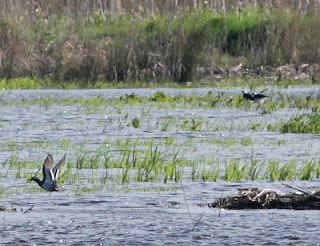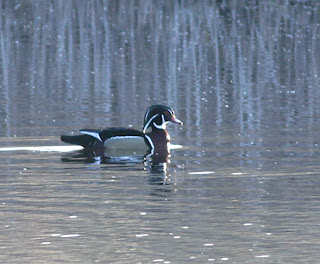I was pretty happy with the 2 Arctic Terns that I saw on Noah's Lake a few days ago, thinking that I had been very lucky to see some at all this Spring, so what happened this afternoon was really quite special. I had gone down to the hide overlooking Canada Lake, a little-visited part of Shapwick Heath NNR, and upon looking out of the window could see 5 terns feeding over the water, all of which turned out to be Arctics. Shortly, another 2 dropped in, and the little group gave a wonderful display as they chased insects around the far side of the lake. After watching them for half an hour hour, a Peregrine Falcon swooped across the lake, presumably hoping to catch an off-guard duck, this spooked the terns and they group together and flew high to the East. Assuming they had moved to Noah's Lake, on the main part of the reserve, I hurried for another look. On getting there I was shocked to see a decent-sized flock of terns, and counted 25 birds, all Arctics! As I watched them for the next hour or so, more arrived, and at one point there were at least 35 Arctic Terns feeding together, a phenomenal sight.
Arctic Terns undertake what is probably the longest annual migration of any living creature. They spend the winter (Summer that side of the equator) in Antarctica, taking advantage of the abundance of krill and lack of competitors and predators, and then fly North to breed on isolated shores. Most nest towards the Arctic Circle, in Iceland and Norway, but there is a British population forming the Southern limit of their breeding range. For most of their migration they follow coastlines, but occasionally a few take a short-cut overland (who can blame them with a journey that long!) and so get seen at place like Shapwick.
I have a huge amount of respect for these birds, the life they lead is absolutely incredible. The effort they go to fill an ecological niche is just mid blowing, and it is always a treat to see them, they're such graceful flyers, and they make what must be an incredible difficult life look so easy.
In 2009 I had the privilege of wardening on
The Farne Islands, where I lived in a small cottage on Brownsman Island with 1000 pairs of Arctic Terns as neighbours. The birds today weren't showing quite so well as the Farnes birds (they used to perch on my head there!), but they still bought back many happy memories from that special place
 |
| Farnes Arctic Tern with its evening meal |
Earlier today, our walk around the reserve produced 'much of the same', with the heron family showing particularly well:
 |
| Great White Egret- the long staying individual ringed as nestling in France |
 |
| Little Egret-with the bluey-pink lores (the fleshy bit between the eye and the beak) of breeding plumage |
 |
| Several Bitterns were flying around, while others boomed from deep in the reed bed |
Passerine migrants are pouring in now, with warblers becoming particularly abundant; Whitethoat, Sedge Warbler, Reed Warbler and Blackcap are joining the dawn chorus in greater numbers every day.
 |
| And this dapper male Wheatear dropped in to feed on some drying peat |
Why not book one of my Guided Walks to join me for a morning or afternoon of birding on Shapwick Heath. SEE MORE, LEARN MORE!
On a somewhat un-related note, it appears as though I contributed towards a first record for Australia today:
http://www.birdforum.net/showthread.php?t=255028. Hopefully this wont be the only time that I ever add a bird species to a national list!

























































